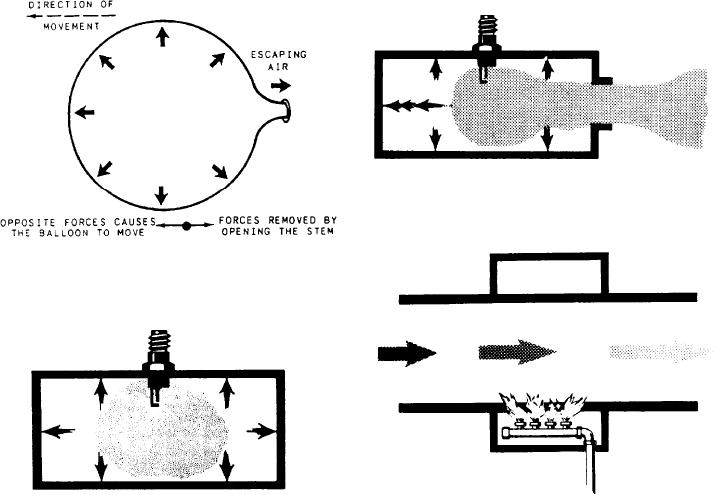
Obviously, propulsion depends solely upon
opening to release the air (fig. 1-2) the balloon
internal conditions. The container does not "push
moves, Its movements appear to be in all direc-
against" external air. In fact, a complete vacuum
tions. Actually, it is always moving in the opposite
would produce greater force. This is the basic
direction from the open end where the air is
operating principle for all jets. The rocket
exiting.
(propulsion unit) is one of the four main classes
Let's look at the balloon example from the
of jet engines.
mechanics point of view. Igniting a hydrocarbon
Before we move on to the physical principles
fuel (compound containing only hydrogen and
of jet engines, let's review the basic principle to
carbon) and oxygen in a closed container (fig. 1-3)
the three other types of jet engines.
releases heat. The burning fuel causes the trapped
gases to expand rapidly. Since the force of the
THE ATHODYD (RAMJET)
pressure is balanced, the container does not move.
Suppose you attach a plain cylinder with open
ROCKET
ends under the wing of an aircraft flying at high
speed. Air enters the front of the duct and leaves
When combustion takes place in a container,
at the rear. Nothing increases the force of flow
the expanding gases rush out at a high velocity
through the duct. There is a loss of energy because
(fig. 1-4). The release of internal pressure
of skin friction and airflow disturbances at the
at the nozzle end of the container leaves an
entrance and exit.
unbalanced pressure at the other end. The
If you add heat energy to the air as it passes
released pressure propels the container (rocket)
through the duct, the air would expand and
in the direction opposite of the exhaust gases.
increase the jet velocity. (Figure 1-5 shows a duct
Figure 1-4.-Principle of jet propulsion.
Figure 1-2.-Balloon example of jet propulsion theory.
Figure 1-5.-Thermal duct with heat added externally to
accelerate the airflow.
Figure 1-3.-Combustion in a closed vessel.
1-2

